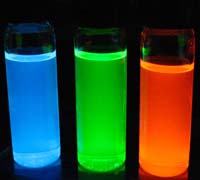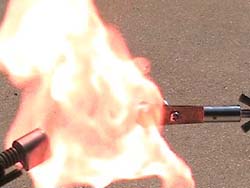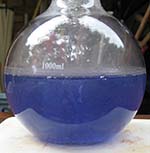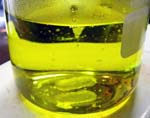Miscellaneous Content
Content (such as pictures, videos, etc …) which might be of interest but does not yet have, or merit, a full-fledged article in another section will be posted here.
Quantum Dots
Quantum dots are semiconducting nanoparticles, typically less than 5 nanometers in diameter, which possess many interesting and unique properties due to their small size. One of the most noticeable properties of quantum dots is their ability to fluoresce when excited. The two pictures below show small amounts of Cadmium Selenide (CdSe) quantum dots, dissolved in toluene, fluorescing brightly as they are exposed to an ultraviolet lamp.
Even though the chemical makeup of the quantum dots is the same, and they are dissolved in an identical solvent, the three vials shown in the pictures are fluorescing in three noticeable different colors (blue ~481 nm, green ~520 nm, orange ~612 nm). This is due to the fact that quantum dots' bandgap (and thus the wavelength of emitted light) depends strongly on the particle size; the smaller the dot, the shorter the emitted wavelength of light. The "blue" quantum dots have the smallest particle size, the "green" dots are slightly larger, and the "orange" dots are the largest.
Gun Cotton
Gun Cotton is similar to flash paper in that the cotton (containing cellulose) has been specially treated and chemically altered to make it burn extremely quickly and produce little to no smoke.
The video, below, shows a comparison between the way an ordinary cotton ball burns compared to a small amount of gun cotton. The ordinary cotton ball burns slowly and leaves behind a lot of black ash and residue. Gun cotton burns completely, in a flash, and leave behind no smoke or ash.
|
Video
|
|---|
Titanium Analysis
In an attempt to assay the Titanium metal content of the product of a Titanium Dioxide thermite reaction, the Ti-metal was dissolved in Hydrochloric acid to yield a solution of Ti+3 ions.
Pictures of the solution taken during a portion of the analysis are shown below.
|
|
|||
|
Last updated:
09/28/2008








